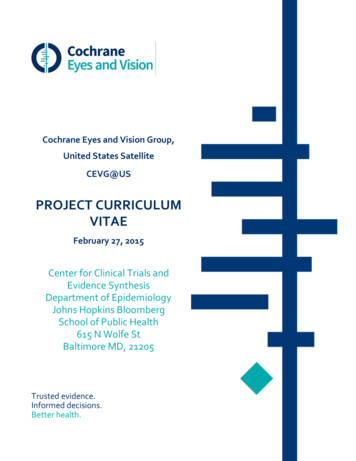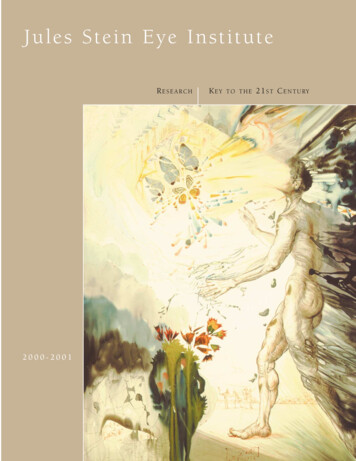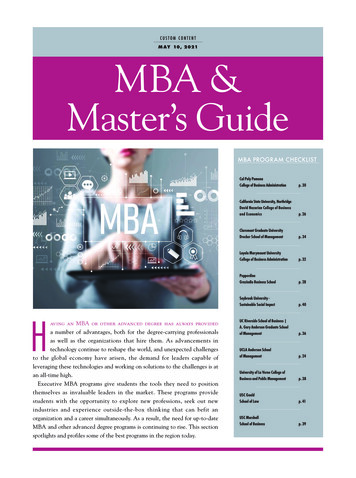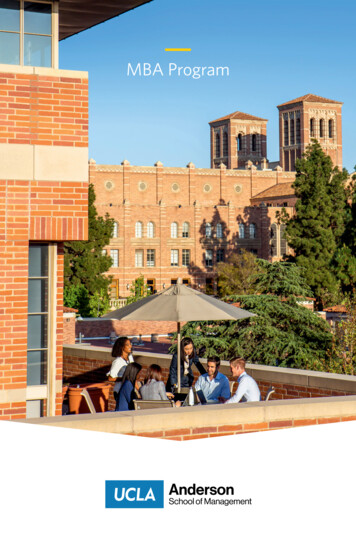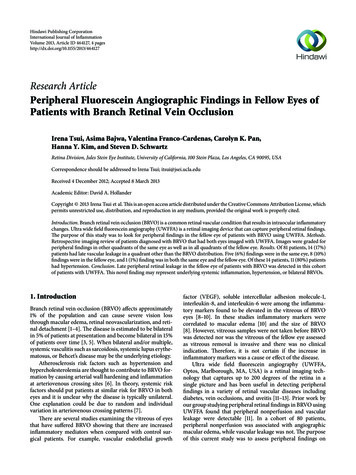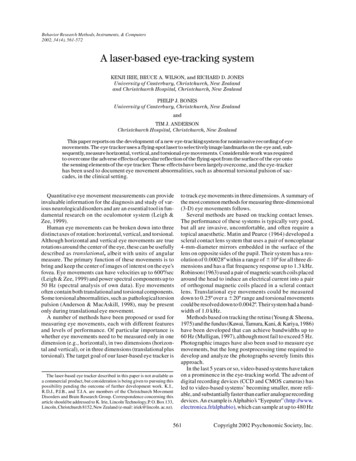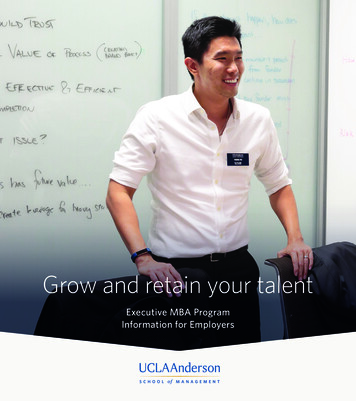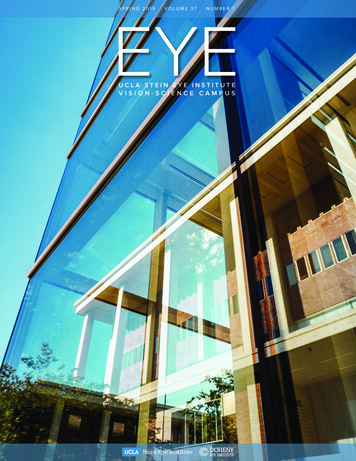
Transcription
SPRING 2019VOLUME 37NUMBER 1EYEUCLA STEIN EYE INSTITUTEVISION-SCIENCE CAMPUS
LETTER FROM THE CHAIRWhere will I become the best ophthalmologist I can possibly be?This is a fundamental question medical school graduates mustconsider when applying to a residency program.The UCLA Department of Ophthalmology has been trainingfuture leaders in ophthalmology for over 50 years, exposing residents to the full breadth of clinical, surgical, and research training taught by world-renowned leaders in their fields.EYE M A G A Z I N Eis a publication of theUCLA Stein Eye InstituteDIRECTORBartly J. Mondino, MDMANAGING EDITORTina-Marie Gauthierc/o Stein Eye Institute100 Stein Plaza, UCLALos Angeles, California 90095–7000Tina@EyeCiteEditing.comPUBLICATION COMMITTEEAnthony C. Arnold, MDKevin M. Miller, MDAlapakkam P. Sampath, PhDAlfredo A. Sadun, MD, PhDM. Gail SummersCONTRIBUTING STAFFSarah JohnsonKara MondinoWRITERSDan GordonHarlan LeboDESIGNRobin Weisz Design 2019, by The Regents of theUniversity of California.All rights reserved.The Stein Eye Institute is a proudaffiliate of the Doheny Eye Institute.In this issue of EYE Magazine, we highlight our UCLA-affiliatedmedical centers and the exceptional training opportunities theyprovide to residents. Through clinical rotations at a diversity oftraining sites, young physicians are exposed to a full range ofophthalmology issues—from complex eye disease to emergencytrauma—and they gain vast amounts of hands-on clinical andsurgical experience. Each day exposes the residents to something new that sharpens their clinical acumen.After three years of comprehensive training, UCLA residentsgraduate with advanced tools, refined skills, and enlightenedideas about the benefits of collaborative medicine. They areexperienced clinicians and surgeons who are fully prepared tolaunch their career forward.Upon their graduation, our residents join an alumni class who—along with their faculty mentors—are making tremendousstrides in furthering our profession. In this issue, we also recognize these leaders and their achievements in advancing eyehealth.Sincerely,Bartly J. Mondino, MDBradley R. Straatsma, MD, Endowed Chair in OphthalmologyDirector, Stein Eye InstituteChairman, UCLA Department of OphthalmologyAffiliation Chairman, Doheny Eye Institute
F E AT U R E SEYESPRING 2019UCLA-Affiliated HospitalsOffer Unique TrainingOpportunities for ResidentsTaught by world-class faculty andexperts in their field, residents in theUCLA Department of Ophthalmologygain vital hands-on clinical and surgicalexperience caring for patients in diversecommunities.VOLUME 37NUMBER 1UCLA STEIN EYE INSTITUTEVISION-SCIENCE CAMPUSPAG E 2RESEARCH FOCUS:NASA Collaboration Aimsto Counteract PotentialVision Complications inLong SpaceflightsI N ST I T UT E N EWSSetting the Agenda for Vision:Drs. Anne Coleman and Lynn GordonResearchers explore ways to reverseor prevent visual issues in astronautsthat are caused by long exposure to aweightless environment.New Faculty AppointmentsFaculty Honors2018 AAO MeetingPAG E 9E D UCAT I ONAesthetic Eyelid and FacialRejuvenation CoursePH ILA N TH RO PY12Dr. Anthony Arnold receives the Mary Oakley Foundation Chair inNeurodegenerative Diseases.1420–21Dr. David Aizuss, President of theCalifornia Medical AssociationAAO Alumni HonorsSecond bus gives patients increased access to eye care.Stein and Doheny Alumni ReceptionIN STITU TE N EWSLiving Legend in Ophthalmology: Dr. Bradley StraatsmaSouthland Physicians ReceiveTraining in Cataract SurgeryA LUM N I B ULL ETI NCOMMU N I TY O U TRE AC HNew UCLA Mobile EYE Clinic Expands Outreach toUnderserved Communities18–1924th Vision-Science ConferenceFOCUSGaining Greater Understanding of Neurological Disordersand Vision16–1815Founding chair of the UCLA Department of Ophthalmology recognized forleading efforts to preserve and restore sight.On the cover: The Doris Stein Building and the Jules Stein Building are reflected in the exterior glassof the Edie & Lew Wasserman Building. The three structures comprise the UCLA Stein Eye Institutevision-science campus.
UCLA-AFFILIATEDHOSPITALSOffer ResidentsUnique TrainingOpportunitiesA KEY ELEMENT OF THEUCLA DEPARTMENT OFOPHTHALMOLOGY’SACCLAIMED PROGRAM INRESIDENT EDUCATION ISCLINICAL ROTATIONS ATHOSPITALS ACROSS LOSANGELES—AN EXPERIENCEUNLIKE ANY OTHERFOR COMPREHENSIVEOPHTHALMOLOGYTRAINING.2EYE UCLA STEIN EYE INSTITUTE Spring 2019
When Benjamin Campbell, MD, a medicalstudent graduating from Baylor Collegeof Medicine in 2015, was exploring thenation’s schools to find the best choice for his res idency in ophthalmology, UCLA popped to the topof his list because of the training provided by pre eminent ophthalmologists, extensive patient contact,and advanced surgical opportunities.But for Dr. Campbell, now a third-year resident,the UCLA Department of Ophthalmology offereda standout opportunity unlike any other residencyprogram.As a key element of UCLA’s three-year program to train doctorsto become comprehensive ophthalmologists, every resident partic ipates in clinical rotations at the Stein Eye Institute vision-sciencecampus in Westwood, the Ronald Reagan UCLA Medical Center,and UCLA-affiliated teaching hospitals: Harbor-UCLA Medical Cen ter in Torrance, Olive View-UCLA Medical Center in Sylmar, and theVeterans Affairs Greater Los Angeles Healthcare System hospitalsin West Los Angeles and North Hills.Each teaching hospital in the rotation serves diverse communitiesof Southern California and provides patient care for vastly differentpopulations with a broad range of ocular issues.“We believe our residency delivers the widest range of experiencesof any program in the country,” says Stacy L. Pineles, MD, Jerome andJoan Snyder Chair in Ophthalmology and residency program directorfor the UCLA Department of Ophthalmology.“The opportunities for training, patient contact, and communityservice offered by rotations at UCLA-affiliated hospitals are uniqueamong residency programs, and are important for medical studentswho are training to become practicing ophthalmologists ready to treatany ocular issue or patient situation that comes in the door.”Comprehensive resident training: critical inSouthern CaliforniaInstruction at such a diverse range of hospitals adds a specializedfacet for UCLA residents, who represent some of America’s premieryoung ophthalmologists-in-training.“Our residents are the best of the best,” says Bartly J. Mondino,MD, chair of the UCLA Department of Ophthalmology and director ofthe Stein Eye Institute. “Every year, 400 graduating medical studentsapply for our program; we interview 60, and we take only eight. So atany given time in our three-year program, we are training 24 doctorsin a broad range of environments that the teaching hospitals provide.”EYE UCLA STEIN EYE INSTITUTE Spring 20193
“We believe our residency offers the widest range of experiences of anyprogram in the country. The opportunities for training, patient contact, andcommunity service offered by rotations at UCLA-affiliated hospitals areunique among residency programs.”STACY L. PINELES, MDDirector, Residency ProgramUCLA Department of OphthalmologyAnd the specialized nature of the pro gram is vital in Southern California, withfewer programs for training than in othermajor metropolitan areas.“In the New York City area, for example,there are more than ten ophthalmology res idency programs—in Los Angeles, there aretwo,” says Pradeep S. Prasad, MD, MBA,chief of the Division of Ophthalmology atHarbor-UCLA. “Our residents are directbeneficiaries of the opportunity to providevital eye care services to the vast populationof patients in our region.”UCLA ophthalmology residents see theadvantages of working with the teachinghospitals from the perspective of how thoseopportunities broaden the scope of theirhands-on experience—and their individualresponsibilities.“Working at the teaching hospitals isan ideal training ground—the best of everyworld,” says Victoria Tseng, MD, PhD, athird-year resident.“When I applied for training in oph thalmology,” says Dr. Tseng, “what reallystood out about UCLA’s program was thediversity of training, the number of patientsin my care, and the independence I wouldreceive as I progressed.“At the teaching hospitals, we are work ing with low-income patients who notonly have medical challenges, but whooften have had only limited access tomedical care—especially for their eyes,”says Dr. Tseng. “We see the spectrumof eye disease—often with opportunities4for tremendous improvement. I routinelyhave patients who are near-blind one dayand after treatment have 20/20 vision—that is a tremendously rewarding outcomefor a resident in training.”Equally important in training new oph thalmologists at the teaching hospitals isthe emphasis on self-reliance.“Some residency programs featurehand-holding approaches—the UCLADepartment of Ophthalmology mandate isindependence,” says Wayne Gui, MD, whocompleted his residency in the Departmentand is now a vitreoretinal surgery fellow atUCLA. “Learning how to be a self-sufficientophthalmologist is especially importantat the teaching hospitals, where we areexpected to make individual decisions andrecommendations when we consult withthe attending physicians.”Venues with specialized challengesEach of the affiliated hospitals presentsits own set of challenges for residents andtheir training. At Olive View, for example,the low-income patient load is especiallyheavy, with more than 25,000 patient vis its each year.“This is a ‘learn by doing’ environment,”says Uday Devgan, MD, FACS, FRCS, chiefof ophthalmology at Olive View.“Here we get to train our residents incare for a population that is truly in need,”says Dr. Devgan, “treating diseases as theyhone their skills along the way.”EYE UCLA STEIN EYE INSTITUTE Spring 2019
“To be certified for independentsurgery in some specialties requirescompleting a total of 20 of theprocedures. Our residents routinely dothat many procedures in one day.”UDAY DEVGAN, MD, FACS, FRCSChief of OphthalmologyOlive View-UCLA Medical CenterThird-Year Resident Dr. Benjamin Campbellperforms cataract surgery at Olive View–UCLA Medical Center in Sylmar.EYE UCLA STEIN EYE INSTITUTE Spring 20195
BROADENING KNOWLEDGE ANDADVANCING LEADERSHIPFor residents interested in academicor administrative careers, the UCLADepartment of Ophthalmology offerstwo unique leadership programs.EyeSTARThe Specialty Training and AdvancedResearch program (EyeSTAR) com bines basic-science research with clin ical practice. Following residency, thetrainee conducts two to three years ofinvestigation as a postdoctoral fellow orthree years of vision-science researchto earn a PhD.“There are plenty of outstanding clin ical training programs in the world, butStein Eye is one of the handful of insti tutions where seasoned clinicians andpioneers of ophthalmic research bothwork under the same roof. No otherprogram can provide the same level ofmentoring as the EyeSTAR program tobecome a successful clinician-scien tist,” says EyeSTAR graduate StephenH. Tsang, MD, PhD, acclaimed clinicalgeneticist at Columbia University andone of a handful of clinicians who candirect the full spectrum of bench-tobedside research.EyeSTAR is recognized by theNational Eye Institute as a model train ing program.EyeMBAFuture leaders of ophthalmology willneed financial, management, and mea surement skills, which are at the core ofan MBA degree curriculum.EyeMBA is a joint program with theUCLA Anderson School of Managementthat combines ophthalmology residencytraining with a master’s degree in busi ness administration. Abilities gainedthrough EyeMBA are broadly applicableto leadership in academia, translationalresearch, health system management,health care delivery, and biomedicalindustry liaison.Following completion of theirophthalmology residency, traineesare enrolled in the UCLA AndersonSchool Fully Employed MBA program,which offers a flexible schedule andfulfills all requirements for obtainingan MBA degree.6“The flag hanging in the operating room lounge is a reminder of the great patients we serve atthe VA and the sacrifices they have made for our country,” says Third-Year Resident Dr. BenjaminCampbell (center), shown with UCLA colleagues Mr. Brian Zukotynski (medical student),Dr. Madeline Yung (ophthalmology resident), Dr. Wade Stoddard (ophthalmology resident), andMs. Minh Thu Nguyen (medical student).WHAT IS RESIDENT TRAINING?Resident training at UCLA is a three-year program that transforms medicaldoctors into comprehensive ophthalmologists.“Besides the tremendous talents of our residents, the strength of ourresidency comes from the breadth and depth of our training,” says Dr. StacyPineles, residency program director for the UCLA Department of Ophthalmology.What do residents learn during their three years? More than 50 years ofrefinement have created a system of training built on a philosophy of step-bystep increases in the residents’ responsibility: initial exposure to ophthalmologyunder total supervision in the first year; in the second year, residents increasetheir knowledge of ophthalmic practice and become more independent; and inthe third year, residents assume full responsibility for treating patients in prepa ration for receiving national accreditation as ophthalmologists.The residents’ work includes studies in the general field of vision scienceand the range of ophthalmic subspecialties, and clinical rotations at a variety ofhospitals (see main article)—all in addition to ongoing classroom instruction,surgical training, and involvement in original research projects.“Our work is on-the-job training,” says Dr. Benjamin Campbell, a third-yearresident. “We always treat patients under the supervision of attending physi cians, but it is our job to staff the clinic, present the cases to faculty or seniorresidents, and determine the course of treatment.”EYE UCLA STEIN EYE INSTITUTE Spring 2019
As at the other teaching hospitals, thesurgical schedule at Olive View is particu larly brisk, with Dr. Devgan and attendingphysicians guiding residents in 5–10 surger ies and 40–50 related procedures each day.As a result of the heavy patient loadand eye problems that are endemic in lowincome populations that result from dia betes and high blood pressure—such asretina issues—UCLA residents receive farmore opportunities for performing surgerythan their counterparts in other residenttraining programs.“To be certified for independent sur gery in some specialties requires complet ing a total of 20 of the procedures,” saysDr. Devgan. “Our residents routinely do thatmany procedures in one day.”Center point for trauma careIn Torrance, UCLA residents training atHarbor-UCLA experience many of the samepatient populations and challenges as theircolleagues at Olive View. Harbor-UCLA,however, includes the added dimension ofbeing a Level I trauma center and receivesa high volume of emergency cases—manyof which involve traumatic injury to the eye.“We see many trauma patients who haveboth vision-threatening and life-threateninginjuries,” says Dr. Prasad. “The high volumeof ocular trauma that we see presents cru cial opportunities for resident training.”“UCLA residents perform all of our sur gical procedures with the guidance of fac ulty members,” Dr. Prasad says. “The depthof experience the residents acquire trainsthem to manage cases from beginning toend. When they have completed their timehere, our residents have received such a richexposure to the field that they can handlevirtually any type of ophthalmic problem.”EYE CARE IN INDIA:AN INTERNATIONAL OPPORTUNITYFOR RESIDENT TRAININGSince 2013, third-year residents with the UCLA Department of Ophthalmology have had the opportunity toparticipate in a groundbreaking eye care program at theAravind Eye Care System in Madurai, India, which hasbecome a model for restoring sight and offering visioncare in low-resource regions worldwide.During the four-week elective, UCLA ophthalmologyresidents work at the Aravind Eye Care Center and learnfirsthand how the organization’s innovative structure provides high-quality eye care in a country where millionsof patients have no ability to pay.Residents, who live in the Aravind facilities, gainexposure to regional eye diseases and are trained inspecialized cataract surgery techniques—all under thesupervision of local experts. Through this experience,residents broaden their skills and gain firsthand knowledge in providing sight-saving procedures to patientswho would otherwise be needlessly blind.Support for those who have servedUCLA residents working at the VeteransAffairs (VA) hospitals in West Los Angelesand North Hills see a different spectrumof patients: military veterans, primarilymen—although with a growing number ofwomen—often older, with age-related eyediseases and conditions, such as maculardegeneration, cataract, and diabetic eyedisease. UCLA residents also treat thevision concerns of veterans who are expe riencing homelessness.“For our residents, serving a rotation atthe VA gives them an opportunity to workwith patients who often have medical con ditions much different from those at theEYE UCLA STEIN EYE INSTITUTE Spring 2019“Serving a rotation at the VA gives our residents an opportunity to workwith patients who often have medical conditions much different fromthose at the county hospitals.”JOANN A. GIACONI, MDChief of the Ophthalmology SectionGreater Los Angeles VA Healthcare System7
county hospitals,” says JoAnn A. Giaconi,MD, chief of the ophthalmology sectionat the Greater Los Angeles VA HealthcareSystem.“Our residents also see some of thesame conditions that are common at OliveView and Harbor,” says Dr. Giaconi, “suchas the effects of diabetes and high bloodpressure—but with the added perspectiveof better control that results from managedtreatment the VA has been providing.”A team approachFor Dr. Campbell, the training he received atUCLA’s affiliated hospitals has provided theadditional depth in his resident experiencethat he was seeking three years ago—alongwith an appreciation for the high level ofcooperation and support that comes in apressurized teaching hospital environment.“At the teaching hospitals, the resi dents work with a team approach,” says Dr.Campbell. “We all see the same patients,and the more experienced residents pro vide guidance for the newer ones. Everyoneworks as a team and stays until the lastpatient is seen. We support and learn fromeach other as we care for our patients. Weare all in this together.”“When they have completed theirtime here, our residents havereceived such a rich exposure tothe field that they can handlevirtually any type of ophthalmicproblem.”PRADEEP S. PRASAD, MD, MBAChief of the Division of OphthalmologyHarbor-UCLA Medical Center8Under the direction of Vitreoretinal Surgery Fellow Dr. Wayne Gui (left), Third-Year ResidentDr. Victoria Tseng performs a pars plana vitrectomy to repair a retinal detachment.EYE UCLA STEIN EYE INSTITUTE Spring 2019
NASACollaborationAims toCounteractPotentialVisionComplicationin LongSpaceflightsBECAUSE OF THEIR PROLONGED EXPOSURE TO A WEIGHTLESSENVIRONMENT, A SIGNIFICANT PROPORTION OF ASTRONAUTSWITH THE INTERNATIONAL SPACE STATIONHAVE EXPERIENCED VISUAL COMPLICATIONS.EYE UCLA STEIN EYE INSTITUTE Spring 20199
“On Earth, where there is gravity, fluid is always pulled to our feet. In the weightless environment of space, it’s beenestimated that there is a two-liter shift of fluid to the head. Given that this headward shift is the leading hypothesisfor the cause of the problems we see in the eyes of astronauts after long-duration flights, our focus in developing acountermeasure is to manipulate this fluid shift.”ALEX HUANG, MD, PHDAssistant Professor of OphthalmologyUCLA Department of OphthalmologyADr. Huang (standing) oversees testing of aresearch subject in the supine position, oneof four study conditions used to simulatethe headward fluid shift that occurs inmicrogravity situations.10UCLA Department of Ophthalmology faculty member is collaborating withNASA—the National Aeronautics and Space Administration—to develop acountermeasure to a vision-related problem that is currently hindering theeffort to send astronauts on a mission to Mars, or on other extended journeys into space.Because of their prolonged exposure to a weightless environment, a significant proportionof astronauts with the International Space Station have experienced visual complications.Many of these effects—including bleeding, folds in the back of the eye, and changes inthe glasses prescription—are short-term and can be resolved when the astronauts returnto Earth. But the most concerning change involves disc edema, or swelling in the nervesof the eye, a cornerstone of a condition referred to as spaceflight-associated neuro-ocularsyndrome (SANS).“A change in eyeglass prescription or a tiny bleed in the retina can be recovered, but aswollen disc can potentially lead to permanent damage,” explains Alex Huang, MD, PhD,a Doheny Eye Institute clinician and scientist. “This is one of the main reasons we don’thave long-haul spaceflight right now. We need to learn how to address this problem, eitherthrough a treatment or a countermeasure that prevents it.”Dr. Huang is a glaucoma specialist whose research has focused on fluid flow in theeye. In collaboration with an industry partner, Heidelberg Engineering, he developed adevice modification, called a FLEX, which situates necessary imaging equipment for realtime ocular fluid flow assessment in patients with and without glaucoma, in a variety ofpositions. That attracted the interest of NASA, which asked Dr. Huang to take the lead indeveloping and studying a countermeasure for SANS, which is believed to be caused bythe redistribution of fluid to the head.“If fluid is redistributing to the astronaut’s head in space, the best way to model thaton Earth is to lay people with their feet up and head down—the so-called head-downtilt—but standard imaging equipment is designed for people sitting upright,” Dr. Huangsays. “When the scientists at NASA realized that we not only have this equipment butare vision scientists at the Doheny Image Reading Center—a center known for its strongimaging—they were very interested in collaborating.”Although several SANS causes have been hypothesized, the headward fluid shift thatoccurs in the weightlessness environment is currently seen as the most likely culprit for theocular-related changes during long-duration spaceflight. “On Earth, where there is grav ity, fluid is always pulled to our feet,” Dr. Huang explains. “In the weightless environmentof space, it’s been estimated that there is a two-liter shift of fluid to the head. Given thatthis headward shift is the leading hypothesis for the cause of the problems we see in theeyes of astronauts after long-duration flights, our focus in developing a countermeasureis to manipulate this fluid shift.”EYE UCLA STEIN EYE INSTITUTE Spring 2019
The potentially mitigating countermea sure Dr. Huang’s team has studied involvesthe use of venoconstrictive thigh cuffs(VTCs). The Russian space agency devel oped a type of VTC called a braslet to keepfluid in the limbs, with some demonstratedsuccess. But the braslet is limiting physicallyin that it requires tying the legs togethertightly to compress the fluid and prevent itfrom shifting; moreover, it was not knownhow VTCs, including braslets, would affectheadward fluid shift as it relates to ocularphysiology.Dr. Huang and his colleagues have inves tigated the ocular implications of usingsingle-leg mobility-enabling thigh cuffsas a SANS countermeasure. “The idea isto pump up the cuff on the leg at a levelthat maintains the flow of blood but slowsthe movement of the fluid from the feetto the head to prevent the redistribution,”Dr. Huang says.At the Doheny Eye Center UCLA–Pasa dena, Dr. Huang’s team tested 40 healthyresearch subjects without known oculardisease for 10 minutes each under fourconditions: sitting posture, supine pos ture (lying on one’s back), head-down tiltposture—meant to simulate the headwardfluid shift that occurs in microgravity con ditions—and head-down tilt posture withthe thigh cuffs. In the study, intra ocularpressure (IOP) increased significantly whensubjects went from the sitting to the supineposition, and further increased when theywent from supine to head-down tilt posi tion. Wearing the thigh cuffs during thehead-down tilt posture resulted in a signifi cantly lower IOP compared to not wearingthe cuffs in that position, though it washigher than when in the seated position.Using the FLEX, the researchers foundthat subfoveal choroidal thickness—alsoknown to elevate during the head-downtilt position—was significantly reducedwhen the research subjects were wearingthe thigh cuffs.“It’s important to note that we weren’trecreating SANS on Earth—no one wasgoing to get a swollen nerve from lyingon their back with their feet upright for10–20 minutes,” Dr. Huang says. “But it isEYE UCLA STEIN EYE INSTITUTE Spring 2019encouraging that in this acute model, whereeye pressure and choroid thickness wereindicators of fluid shift, the countermea sure seemed to reverse those changes.”The next step, Dr. Huang says, is to testthe thigh cuffs over a much longer period oftime, and ultimately to study them in space.As part of a seven-year grant fromNASA, Dr. Huang and his colleagues areinvestigating SANS countermeasures atthe same time they are conducting studiesto ensure that the hypothesis for the SANScause is correct. Although headward fluidshift is the leading hypothesis, other causeshave been proposed, such as radiation fromthe sun and elevated carbon dioxide levels.“Typically, research first aims to understandwhat’s happening, and then to develop atreatment or countermeasure,” Dr. Huangsays. “But in this case, there is such anurgency to address this issue that we aredoing both at the same time. Whether ourgoal is going to Mars, which would be aboutan 18-month commitment, or pursuing alunar station, we have to solve this problem.For any future manned missions beyond lowEarth orbit, we need countermeasures toreverse or prevent SANS.”The Doheny Eye Institute signed a historicpartnership with UCLA in 2013—joining forceswith the Stein Eye Institute and creating thenation’s largest academic affiliation. Formingthe UCLA Department of Ophthalmology, thecombined strengths of the two Institutes areexpanding the care of patients and broadening efforts in vision science and technology.President and Chief Scientific Officer ofthe Doheny Eye Institute Dr. SriniVas Sadda(standing at the lectern) at a jointtechnological exchange with NASAscientists regarding implementation andanalyses methods for ocular blood flowimaging technology deployed to theInternational Space Station.Dr. Alex Huang (center, pink tie) andDr. SriniVas Sadda (center, dark blue suit) areshown with Dr. Brandon Macias (immediateleft of Dr. Huang)—one of the lead NASAscientists on the collaborative project—andhis team.11
PhilanthropyGaining Greater Understanding ofNeurological Disorders and VisionOphthalmologists at the UCLA SteinEye Institute are looking for linksbetween neurodegenerative disor ders and eye function. Anthony C. Arnold,MD, chief of the Neuro-OphthalmologyDivision at Stein Eye, was celebratedas the inaugural recipient of the MaryOakley Foundation Chair in Neurodegenerative Diseases on October 17, 2018. Bartly J.Mondino, MD, director of the Institute andchair of the UCLA Department of Ophthal mology, said of the generous gift, “JulesOakley memorialized his wife by estab lishing the Mary Oakley Foundation, and Iam honored by the commitment the MaryOakley Foundation and the UCLA Stein EyeInstitute share in advancing vision-scienceresearch. Investments such as the one fromthe Mary Oakley Foundation stand as avital partnership to ensure the continuedexcellence of Stein Eye.”William C. Stivelman, MD, chief exec utive officer and medical director of theMary Oakley Foundation, facilitated theChair’s endowment. The Chair will sup port academic research activities of a dis tinguished faculty member in the area ofneurodegeneration. Neurodegenerativediseases represent a large group of neu rological disorders, with Alzheimer’s Dis ease being one of the most common. Themost consistent risk factor for developinga neurodegenerative disease is increasingage, and with an expanding population ofpeople over the age of 65, research in thisfield is critical.To the lay public and non-caregivers,Alzheimer’s Disease is a disease of ‘forget fulness,’ yet, it affects more than memory.Dr. Stivelman noted, “Alzheimer’s Diseasehas a multifactorial impact upon the ner vous system, including the organs of spe cial sense, which are indeed an integralpart of the nervous system. This includesvision, hearing, taste, and smell. Each playsa significant role in nervous system func tion, and research of the organs of special12Dr. William Stivelman, chief executive officer and medical director of the Mary Oakley Foundation(left) and Dr. Bartly Mondino (center) join Dr. Anthony Arnold, the recipient of the Mary OakleyChair, at a reception at the Stein Eye Institute on October 17, 2018.sense will provide contributory informationas to causality of Alzheimer’s Disease andrelated senior dementias.” He continued,“As Alzheimer’s Disease impacts howinformation is gathered, processed, andinterpreted by the brain, especially in thelater stages of the disease, many who areafflicted often appear seriously vision andhearing impaired.”Dr. Arnold explained that patients withAlzheimer’s Disease present differentlythan the traditional geriatric patient hetreats in clinic. “The patients often havevague visual complaints that are difficultto evaluate due to cognitive issues. Rec ognition of these aspects allows earlierand more effective management of theirvisual problems.”Affected patients often prese
campus in Westwood, the Ronald Reagan UCLA Medical Center, and UCLA affiliated teaching hospitals: Harbor UCLA Medical Cen ter in Torrance, Olive View UCLA Medical Center in Sylmar, and the Veterans Affairs Greater Los Angeles Healthcare System hospitals in West Los Angeles and North Hills.


